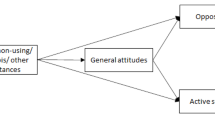Abstract
The present study was designed to compare school personnel's (i.e., principals, counselors, teachers) estimates of student substance use with student self-reported data. Comparisons were made in 78 schools between 5431 student self-reports of tobacco, alcohol, and drug use and 170 school personnel's estimates of student substance use. The results indicated that a significant number of school personnel were unable to estimate student substance use. Personnel who did provide estimates typically underestimated the degree of substance use, in comparison to student self-reported substance use. School personnel did not significantly overestimate use in comparison to student self-reported substance use for any substance in any grade or geographic area. It is suggested that school personnel may resist the adoption of prevention programs because of a perceived lack of need due to underestimation of the substance use problem.
Similar content being viewed by others
References
Bauman, K. E., Koch, G. G., and Bryan, E. S. (1982). Validity of self-reports of adolescent cigarette smoking.Int. J. Addict. 17: 1131–1136.
Botvin, E. M., Botvin, G. L., Renick, A. D., and Filazzola, J. P. (1984). Adolescents' self reports of tobacco, alcohol, and marijuana use: Examining the comparability of videotape, cartoon, and verbal bogus pipeline procedures.Psychol. Rep. 55: 379–386.
Botvin, G., and Eng, A. (1980). A comprehensive school-based smoking prevention program.J. Sch. Health 50: 209–213.
Boyle, M. H., and Offord, D. R. (1986). Smoking, drinking, and use of illicit drugs among adolescents in Ontario: Prevalence, patterns of use and sociodemographic correlates.Can. Med. Assoc. J. 135: 1113–1121.
Brook, J., Lukoff, I., and Whiteman, M. (1977). Peer, family and personality domains as related to adolescents' drug behavior.Psychol. Rep. 41: 1095–1102.
Brook, J., Whiteman, M., Brook, D., and Gordon, A. (1981). Paternal determinants of male adolescent marijuana use.Dev. Psychol. 17: 841–847.
Brownson, R. C., DiLorenzo, T. M., Van Tuinen, M., and Finger, W. W. (1990). Patterns of cigarette and smokeless tobacco use among children and adolescents.Prev. Med. 19: 170–180.
Chassin, L., Presson, C., Bensenberg, M., Corty, E., Olshavsky, R., and Sherman, S. J. (1981). Predicting adolescents' intentions to smoke cigarettes.J. Health Soc. Behav. 22: 445–455.
Connolly, G. N., Winn, D. M., Hecht, S. S., Henningfield, J. E., Walker, B., Jr., and Hoffman, D. (1986). The reemergence of smokeless tobacco.N. Engl. J. Med. 314: 1020–1027.
Department of Commerce (1983).1980 Census of Population. Detailed Population Characteristics. Missouri, U.S. Government Printing Office, Washington, D.C.
DiLorenzo, T. M., Finger, W. W., and Sylvester, J. (1988). Identification of factors for a smokeless tobacco study: Attitudes of teachers, counselors and principals. Unpublished raw data.
Evans, R. I. (1976). Smoking in children: Developing a social psychological strategy of deterrence.Prev. Med. 5: 122–127.
Finger, W. W., DiLorenzo, T. M., Brownson, R. C., Van Tuinen, M., and McCalla, T. L. (1990). Design and methods in a statewide cigarette and smokeless tobacco use survey (unpublished manuscript).
Henningfield, J. E. (1986). Evidence that smokeless tobacco use may lead to dependence. NIH Consensus Development Conference: Health Implications of Smokeless Tobacco and Abstracts.
Johnston, L., O'Malley, P., and Eveland, L. (1978). Drugs and delinquency: A search for causal connections. In Kandel, D. B. (ed.),Longitudinal Research on Drug Use: Empirical Findings and Methodological Issues, Wiley, New York.
Johnston, L. D., O'Malley, P. M., and Bachman, J. G. (1986).Drug Use Among American High School Students, College Students, and Other Young Adults: National Trends Through 1985, U.S. Government Printing Office, Washington, D.C.
Kandel, D. B. (ed.) (1978).Longitudinal Research on Drug Use: Empirical Findings and Methodological Issues, Wiley, New York.
Mahboubi, E., and Sayed, G. M. (1982). Oral cavity and pharynx. In Schottenfeld, D., and Fraumeni, J. F., Jr. (eds.),Cancer Epidemiology and Prevention, W. B. Saunders, Philadelphia, pp. 583–595.
McGinnis, J. M., Shopland, D., and Brown, C. (1987). Tobacco and health: Trends in smoking and smokeless tobacco consumption in the United States.Annu. Rev. Publ. Health 8: 441–467.
Murray, D. M., and Perry, C. L. (1987). The measurement of substance use among adolescents: When is the ‘bogus pipeline’ method needed?Addict. Behav. 12: 225–233.
National Institute on Drug Abuse (1986). 1985 National Household Survey on Drug Abuse. Preliminary results presented at the NIH Consensus Development Conference on the Health Implications of Smokeless Tobacco Use.
Oei, T. P. S., and Fei, A. (1987). Smoking prevention program for children: A review.J. Drug Educ. 17: 11–42.
Paton, S., Kessler, R., and Kandel, D. B. (1977). Depressive mood and adolescent illegal drug use: A longitudinal analysis.J. Genet. Psychol. 131: 267–289.
Rothman, K. J. (1990). No adjustments are needed for multiple comparisons.Epidemiology 1: 43–46.
U.S. Department of Health and Human Services (1982).The Health Consequences of Smoking. Cancer. A Report of the Surgeon General, DHHS (PHS) Publication Number 82-50179, U.S. Government Printing Office, Washington, D.C.
U.S. Department of Health and Human Services, Office of the Inspector General (1986).Youth use of Smokeless Tobacco: More than a Pinch of Trouble, DHHS Publication Number P-06-86-0058, U.S. Government Printing Office, Washington, D.C.
U.S. Department of Health and Human Services, Public Health Service (1988).The Health Consequences of Smoking: Nicotine Addiction: A Report of the Surgeon General, DHHS Publication Number (CDC) 88-8406, U.S. Government Printing Office, Washington, D.C.
Author information
Authors and Affiliations
Additional information
This study was supported in part by U.S. Public Health Service Grant R01 CA45576 01 awarded by the National Cancer Institute.
Rights and permissions
About this article
Cite this article
DiLorenzo, T.M., Welton, G.L., McCalla, T.L. et al. Underestimates of student substance use by school personnel: A cause for concern?. J Behav Med 14, 397–407 (1991). https://doi.org/10.1007/BF00845115
Accepted:
Issue Date:
DOI: https://doi.org/10.1007/BF00845115



